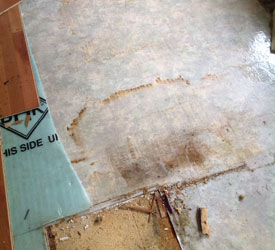They are making a number of great annotation on Looking for Signs of Water Damage in the Bathroom in general in the article just below.

The washroom is extremely vulnerable for moist build-up and prospective water damage because of the constant use water in it. This write-up supplies simple evaluation methods to assist finding water damages threats.
The frequent use of water in the bathroom makes it extremely susceptible for damp build-up as well as potential water damage. By inspecting it routinely, you can reduce water related damages.
The following set of inspections is very easy to execute and also must be done as soon as in every 3 months in order to maintain your shower room healthy as well as to avoid potential water damages caused by the bathtub, the shower, pipeline joints and also plumbing, sinks, closets, and also the bathroom
Do not disregard carrying out these evaluations and be thorough while executing them. Bear in mind that these easy examinations can conserve you a great deal of money by providing very early signs for water damages
Bathtub and Shower
The shower and also bath tub need special attention and also upkeep. Inspect the tiles and also change if broken. See to it that there is no missing out on grout in between the ceramic tiles. Examine and change broken caulking at joints where the walls meet the flooring or the tub. Clogged drains pipes and also pipes problems will certainly avoid the bathtub from drying out as well as may show major problems under the tub. Consult with a specialist right away to prevent architectural damage. Take notice of discolorations or soft locations around the tub wall surfaces as they may indicate an interior leak.
Plumbing
Signs for water damages are hard to discover since the majority of pipes are mounted inside the walls.
Pay unique interest to floor covering as well as walls wetness and spots as they may suggest an unseen plumbing problem. Inspect dampness levels in adjacent areas as well.
Sinks as well as Cabinets
Sinks and also closets are exposed to moisture and moisture daily as well as are often neglected. Evaluate frequently under the sink and on the countertop over it. Fix any drip in the catch as it may recommend drain troubles. Browse the sink, slow-moving draining pipelines may suggest a blocked drain. Change sink seals if they are cracked or loose.
The Commode
The toilet is a susceptible water joint. Examine the water lines and also search for leaks around the commode seat, in the hose, and under the water storage tank. If you detect any type of indicators of moisture on the flooring around the toilet, check for leaks in the toilet rim and storage tank seals.
Know that hanging commode dish antiperspirants increases the chances for clogs.
Water Damage Signs In The Bathroom To Avoid Cleanup
Musty smell
This is one of the easiest signs to catch because musty smells are so odorous. The damp, earthy, moldy smell should be a big red flag. The smell will develop when moisture gets trapped in surfaces, and begins to facilitate mold growth. Leaking pipes under cabinets, inside walls, and behind shower fixtures will cause moisture to stay trapped and not dry, which will lead to mold growth and spread. As soon as you notice any musty smells in your bathroom, have it checked for hidden water damage and cleanup signs.
Visible mold
If the smell isn’t there to give it away, sometimes you will actually see mold growth. Finding mold in your bathroom is a serious problem, because mold is very harmful to your health. By the time mold growth is visible, it also means that water damage has already occurred and been present for some time. The only way the mold problem can be resolved is to find the source of the moisture and get it stopped. To safely and adequately remove mold, you need to have professionals handle the remediation. Do not waste any time in getting mold problems addressed, fixed, and sanitized so that you can protect you and your family from the many respiratory symptoms caused by mold exposure.
Damaged floors
Bathroom floors should be able to withstand some exposure to water while still remaining in good condition. However, when excess exposure or water leaks occur, they will begin to damage even the most water-resistant flooring. If you notice any cracking, bubbling, staining, or warping on your bathroom floors, there is probably a water leak somewhere causing the distortion. If you notice areas of the floor have become softer, or even have a spongy feeling, there is probably damage to the subfloor. Subflooring is typically made up of plywood. When plywood is exposed to water or moisture, it will absorb it. Once it has become saturated, the weight of the excess water will cause the wood to swell and soften. Check the floors in your bathroom frequently to catch any of these sings before they lead to damaged subflooring.
Changes on walls
When water leaks behind walls, it will cause changes in the drywall. Peeling plaster, blistering paint, and soggy wallpaper are all good indicators that excess water is building up behind the wall. Water leaking behind drywall will cause it to swell and be soft to the tough. If you start to notice gaps along the trim of your walls, or where tile meets the wall, it could also be a strong indicator that there is a leak behind the wall. Any changes, distortion, or damage on the walls should be evaluated as soon as you notice it to prevent further water damage and cleanup.

I discovered that blog posting about How to Repair and Prevent Bathroom Water Damage while doing a lookup on the web. Loved our article? Please share it. Let another person locate it. Thanks a lot for your time. Kindly come visit our blog back soon.
About This